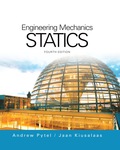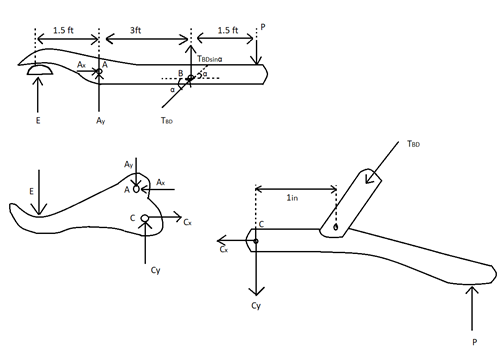
International Edition---engineering Mechanics: Statics 4th Edition
4th Edition
ISBN: 9781305856240
Author: Pytel
Publisher: Cengage
expand_more
expand_more
format_list_bulleted
Concept explainers
Textbook Question
Chapter 10, Problem 10.36P
For the pliers shown, determine the relationship between the magnitude of the applied forces P and the magnitude of the gripping forces at E. (Hint: Consider AB to be fixed.)

Expert Solution & Answer
Trending nowThis is a popular solution!

Students have asked these similar questions
Fy = 100 N
Fx = 100 N
Z
a = 500 mm
F₂ = 500 N
b = 1000 mm
Figure 2: Schematics for problem 3.
1. Draw the moment (M), axial (N), and shear (S) diagrams. Please note that this is a 3D problem and you
will have moment (M) and shear (S) along two different axes. That means that you will have a total of 5
diagrams.
I tried solving this one but have no idea where I went wrong can you please help me out with this?
Question 1.
A tube rotates in the horizontal xy plane with a constant angular velocity w about the z-axis. A
particle of mass m is released from a radial distance R when the tube is in the position shown.
This problem is based on problem 3.2 in the text.
y
ω
R
m
2R
Figure 1
X
a) Draw a free body diagram of the particle if the tube is frictionless.
b) Draw a free body diagram of the particle if the coefficient of friction between the sides of the
tube and the particle is μs = flk = fl.
c) For the case where the tube is frictionless, what is the radial speed at which the particle
leaves the tube?
d) For the case where there is friction, derive a differential equation that would allow you to
solve for the radius of the particle as a function of time. I'm only looking for the differential
equation. DO NOT solve it.
e) If there is no friction, what is the angle of the tube when the particle exits?
• Hint: You may need to solve a differential equation for the last part. The "potentially…
Chapter 10 Solutions
International Edition---engineering Mechanics: Statics 4th Edition
Ch. 10 - Determine the number of DOF for each of the...Ch. 10 - The uniform bar of weight W is held in equilibrium...Ch. 10 - Bars AB and AC of the mechanism are homogenous...Ch. 10 - The weight of each homogeneous bar of the linkage...Ch. 10 - The 1800-kg boat is suspended from two parallel...Ch. 10 - The 2.4-kg lamp, with center of gravity located at...Ch. 10 - The linkage is made of two homogenous bars of...Ch. 10 - For the frame shown, find the horizontal component...Ch. 10 - The four-bar linkage supports the homogeneous box...Ch. 10 - Prob. 10.10P
Ch. 10 - Determine the ratio P/Q of the forces that are...Ch. 10 - Find the vertical force P that will hold the...Ch. 10 - The linkage of the braking system consists of the...Ch. 10 - The automatic drilling robot must sustain a thrust...Ch. 10 - Determine the couple C for which the mechanism...Ch. 10 - The scissors jack is used to elevate the weight W....Ch. 10 - Prob. 10.17PCh. 10 - Calculate the torque C0 that must be applied to...Ch. 10 - Determine the force F and the angle a required to...Ch. 10 - Locate the instant center of rotation of bar AB...Ch. 10 - Prob. 10.21PCh. 10 - Determine the force P that will keep the mechanism...Ch. 10 - Prob. 10.23PCh. 10 - Prob. 10.24PCh. 10 - Prob. 10.25PCh. 10 - Determine the ratio P/Q for which the linkage will...Ch. 10 - Prob. 10.27PCh. 10 - Prob. 10.28PCh. 10 - If the input force to the compound lever is P = 30...Ch. 10 - Determine the roller reaction at F due to the...Ch. 10 - Prob. 10.31PCh. 10 - Prob. 10.32PCh. 10 - Prob. 10.33PCh. 10 - Prob. 10.34PCh. 10 - Prob. 10.35PCh. 10 - For the pliers shown, determine the relationship...Ch. 10 - When activated by the force P, the gripper cm a...Ch. 10 - Prob. 10.38PCh. 10 - The hinge is of the type used on some automobiles,...Ch. 10 - The spring attached to the sliding collar is...Ch. 10 - The weight W is suspended from end B of the...Ch. 10 - The uniform bar of weight W and length L = 1.8R...Ch. 10 - A slender homogeneous bar is bent into a right...Ch. 10 - The body shown is a composite of a hemisphere and...Ch. 10 - Prob. 10.45PCh. 10 - The uniform bar AB of weight W and length L is...Ch. 10 - Uniform rods of weights W1 and W2 are welded to...Ch. 10 - Prob. 10.48PCh. 10 - The semi-cylinder of radius r is placed on a...Ch. 10 - Prob. 10.50PCh. 10 - The spring attached to the homogenous bar of...Ch. 10 - The spring is connected to a rope that passes over...Ch. 10 - Find the equilibrium positions of the 30-lb...Ch. 10 - The mechanism of negligible weight supports the...Ch. 10 - Solve Prob. 10.54 assuming that A and B are...Ch. 10 - The stiffness of the ideal spring that is...Ch. 10 - Find the stable equilibrium position of the system...Ch. 10 - The uniform bar AB of weight W = kL is in...Ch. 10 - The weight of the uniform bar AB is W. The...Ch. 10 - The weightless bars AB and CE, together with the...Ch. 10 - Prob. 10.61PCh. 10 - The bar ABC is supported by three identical, ideal...
Knowledge Booster
Learn more about
Need a deep-dive on the concept behind this application? Look no further. Learn more about this topic, mechanical-engineering and related others by exploring similar questions and additional content below.Similar questions
- I tried this problem but I can't seem to figure out what I am missing here can you please help me?arrow_forwardSolve 4.9 row a USING THE ANALYTICAL METHODarrow_forwardcutting Instructions: Do not copy the drawing. Draw In third-angle orthographic projection, and to scale 1:1, the following views of the hinge: A sectional front view on A-A A top view ⚫ A right view (Show all hidden detail) Show the cutting plane in the top view . Label the sectioned view Note: All views must comply with the SABS 0111 Code of Practice for Engineering Drawing. Galaxy A05s Assessment criteria: ⚫ Sectional front view 026 12 042 66 [30] 11 10arrow_forward
- 1. Plot the moment (M), axial (N), and shear (S) diagrams as functions of z. a) b) F₁ = 1250 N F₁ = 600 N M₁ = 350 000 N mm F2 = 500 N 200 N a = 600 mm b=1000 mm a=750 mm b = 1000 mm d) M₁ = 350 000 N mm F₁ = 600 N F₂ =200 N a = 600 mm b = 1000 mm M₁ 175 000 Nmm F = 900 N a-250 mm b-1000 mm -250 mm. Figure 1: Schematics problem 1.arrow_forwardGiven the following cross-sections (with units in mm): b) t=2 b=25 h=25 t = 1.5 b=20 b=25 t=2 I t = 1.5 a=10 b=15 h-25 b=15 t=3 T h=25 Figure 3: Cross-sections for problem 2. 1. For each of them, calculate the position of the centroid of area with respect to the given coordinate system and report them in the table below. 2. For each of them, calculate the second moments of inertia I... and I, around their respective centroid of area and report them in the table below. Note: use the parallel axes theorem as much as possible to minimize the need to solve integrals. Centroid position x y box Moment of inertia lyy by a) b) c) d) e)arrow_forwardProblem 1: Analyze the canard-wing combination shown in Fig. 1. The canard and wing are made of the same airfoil section and have AR AR, S = 0.25, and = 0.45% 1. Develop an expression for the moment coefficient about the center of gravity in terms of the shown parameters (, and zg) and the three-dimensional aerodynamic characteristics of the used wing/canard (CL C and CM). 2. What is the range of the cg location for this configuration to be statically stable? You may simplify the problem by neglecting the upwash (downwash) effects between the lifting surfaces and the drag contribution to the moment. You may also assume small angle approximation. Figure 1: Canard-Wing Configuration.arrow_forward
- Problem 2: Consider the Boeing 747 jet transport, whose layout is shown in Fig. 2 and has the following characteristics: xoa 0.25, 8 5500/2, b 195.68ft, 27.31ft, AR, 3.57, V = 0.887 Determine the wing and tail contributions to the CM-a curve. You may want to assume CM, reasonable assumptions (e.g., -0.09, 0, -4°. i=0.0°, and i = -2.0°. Make any other 0.9).arrow_forwardZ Fy = 100 N Fx = 100 N F₂ = 500 N a = 500 mm b = 1000 mm Figure 2: Schematics for problem 3. 1. Draw the moment (M), axial (N), and shear (S) diagrams. Please note that this is a 3D problem and you will have moment (M) and shear (S) along two different axes. That means that you will have a total of 5 diagrams.arrow_forwardAn ideal gas with MW of 29 g/mol, cp = 1.044 kJ/kgK and c₁ = 0.745 kJ/kgK contained in a cylinder-piston assembly initially has a pressure of 175 kPa, a temperature of 22°C, and a volume of 0.30 m³. It is heated slowly at constant volume (process 1-2) until the pressure is doubled. It is then expanded slowly at constant pressure (process 2-3) until the volume is doubled. Draw a figure of the system and the PV diagram showing each state and the path each process takes. Determine the total work done by the system and total heat added (J) in the combined process.arrow_forward
- please explain each method used, thank youarrow_forwardDetermine the resultant loadings acting on the cross sections at points D and E of the frame.arrow_forwardA spring of stiffness factor 98 N/m is pulled through 20 cm. Find the restoring force and compute the mass which should be attached so as to stretch in spring by same amount.arrow_forward
arrow_back_ios
SEE MORE QUESTIONS
arrow_forward_ios
Recommended textbooks for you
 International Edition---engineering Mechanics: St...Mechanical EngineeringISBN:9781305501607Author:Andrew Pytel And Jaan KiusalaasPublisher:CENGAGE L
International Edition---engineering Mechanics: St...Mechanical EngineeringISBN:9781305501607Author:Andrew Pytel And Jaan KiusalaasPublisher:CENGAGE L

International Edition---engineering Mechanics: St...
Mechanical Engineering
ISBN:9781305501607
Author:Andrew Pytel And Jaan Kiusalaas
Publisher:CENGAGE L
Hand Tools; Author: UCI Media;https://www.youtube.com/watch?v=4o0tqF0jDdo;License: Standard Youtube License